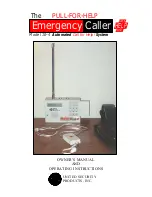
The VLAN default value and priority tagging
The parameter L2QVLAN identifies the 802.1Q VLAN Identifier and is initially set to 0. This default
value indicates
priority tagging
and specifies that your network Ethernet switch automatically insert
the default VLAN ID without changing the user priority of the frame.
But some switches do not process a VLAN ID of zero and require frames tagged with a non-zero
VLAN ID.
If you do not want the default VLAN to be used for voice traffic, set the value of L2QVLAN to the
VLAN ID appropriate for your voice LAN.
You can also administer another parameter VLANTEST that defines the number of seconds the
phone waits for a DHCPOFFER message when using a non-zero VLAN ID. The VLANTEST
default is
60
seconds. If you use VLANTEST, the deskphone returns to the default VLAN if an
invalid VLAN ID is administered or if the phone moves to a port where the L2QVLAN value is
invalid.
The default value of VLANTEST is long, allowing for the scenario that a major power interruption
is causing the phones to restart. Always allow time for network routers, the DHCP servers, and
other equipment to be returned to service. If the deskphone restarts for any reason and the
VLANTEST time limit expires, the administered VLAN ID becomes invalid. The deskphone then
initiates operation with a VLAN ID of 0. Or, if the value of L2Q is 0, that is auto, the deskphone
turns off tagging until the L2QVLAN is set to a non-zero value or until the deskphone verifies that
the network can support tagged frames.
Setting VLANTEST to “0” causes the phone to use a non-zero VLAN indefinitely to attempt DHCP.
In other words, the deskphone does not return to the default VLAN.
Related links
on page 132
Automatic detection of a VLAN
The phones support automatic detection of the L2QVLAN setting that is incorrect. When the value
of L2QVLAN is not 0 and VLAN tagging is enabled, L2Q= 0 or 1, initially the IP Deskphone
transmits DHCP messages with IEEE 802.1Q tagging and sets the VLAN ID to L2QVLAN. The
phones will continue to do this for number of seconds configured by VLANTEST.
• If L2Q=1 and the VLANTEST timer expires because the phone has not received a
DHCPOFFER, the phone sets L2QVLAN=0 and transmits DHCP messages with the default
VLAN (0).
• If L2Q=0 and the VLANTEST timer expires because the phone has not received a
DHCPOFFER, the phone sets L2QVLAN=0 and transmits DHCP messages without tagging.
• If VLANTEST is 0, the timer never expires.
Note:
Regardless of the setting of L2Q, VLANTEST, or L2QVLAN, you must have administer
DHCP on the phone so that the phone receives a response to a DHCPDISCOVER on
making that request on the default (0) VLAN.
Administering Deskphone Options
May 2018
Installing and Administering Avaya J169/J179 IP Phone H.323
133
















































